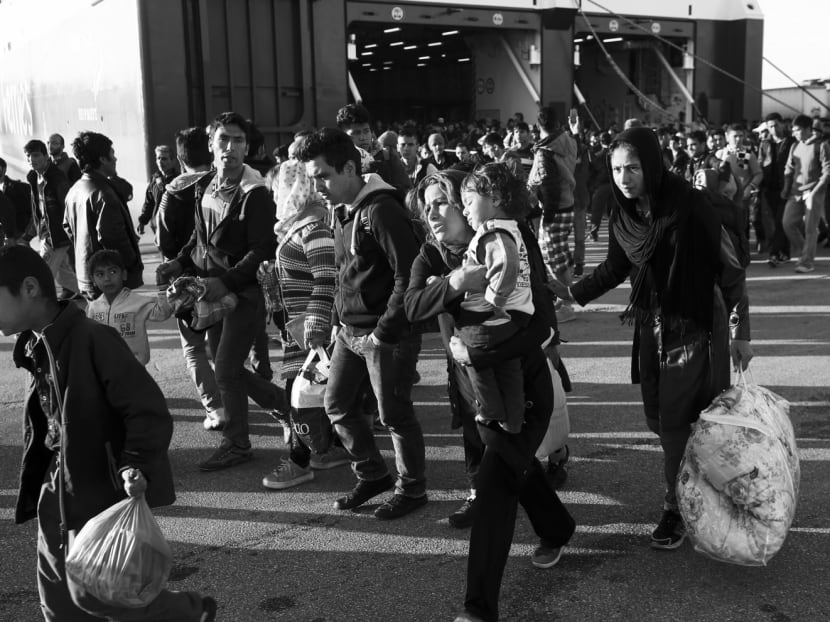Islamic State ‘sleeper cells’ not the real fear around refugee exodus
Fears of Islamic State (IS) “sleeper cells” infiltrating Europe on the back of the recent refugee exodus and creating anything from lone-wolf to 9/11 style attacks have been highlighted in recent weeks by the media, conservative politicians and far-right groups.

Migrants and refugees disembarking from a ferry at the Athens port of Piraeus after their arrival from the Greek island of Lesbos. Countries taking in these refugees cannot simply be content to accommodate them, even though this is a useful start. Photo: AP
Fears of Islamic State (IS) “sleeper cells” infiltrating Europe on the back of the recent refugee exodus and creating anything from lone-wolf to 9/11 style attacks have been highlighted in recent weeks by the media, conservative politicians and far-right groups.
Although there have, indeed, been calls by the IS for sleeper-cell attacks following the United States-led coalition airstrikes on IS-held territory, hard evidence of an organised attempt to plant cells within the refugee exodus is hard to come by.
Unpicking the actual facts behind a scattered melange of rumour and scaremongering is even more challenging.
Far more worrying, few appear focused on what this all means for Europe over the longer term.
It is unfortunate that there has been so little informed debate on the wider ramifications of the influx of migrants to Europe, and surprising that so little of the current soul-searching has extended to how these refugees can become part of real communities.
The arrival of the refugees will inevitably shift mainstream political discourse and shape the future socio-political landscape. In the United Kingdom and some European countries, right wing movements (think the English Defence League and Pegida) and their opponents (not just Islamist groups) are locked in a symbiotic spiral of reciprocal radicalisation.
For example, Norway’s domestic intelligence agency has observed that the domestic threat level has increased, not because of the wave of asylum seekers, but on account of the visceral response of far-right groups, with the concomitant possibility of far-left extremist groups in turn mobilising against them.
Those determined to pinpoint incipient and genuine threats within the refugee exodus might, perhaps, be better advised to examine the coming battle for the hearts and minds of the new arrivals — a battle that is likely to see split pathways of alienation and integration.
Consider, for example, the warnings from intelligence officials in countries ranging from Germany to Norway, noting that some refugees could be vulnerable to radicalisation.
Some reports suggest that Salafists and other extremists in countries such as Germany have attempted to reach out and recruit recently-arrived refugees from Syria — warning them against succumbing to Western values. These reports are more credible than those suggesting that mass infiltration by IS cells has taken place.
MEASURES TO INTEGRATE AND INNOCULATE
Countries taking in these refugees cannot simply be content to accommodate them, even though this is a useful start.
Extraordinary measures will be required to facilitate the integration of these individuals who in many cases are traumatised and persecuted. But right now, even more innovative steps will be needed to inoculate against extremism in the future.
In many parts of Europe, there already exist upstream, early-intervention community-level initiatives aimed at individuals potentially at risk of radicalisation. The Channel Programme in the UK is a case in point. These programmes mobilise key influencers, local community actors, trusted NGOs and social workers to act on, and influence, at-risk individuals. Police are involved, too, but the overall approach has been non-securitised.
Useful parallels exist in some European countries, where there are ongoing attempts to build resilient local-level networks. Amsterdam has a programme leveraging on “key influencers” — young people who are in leadership positions within critical community networks ranging from women’s groups, informal sports clubs to mosques.
In some cases, these influencers are given a small amount of seed money to do what amounts to “diversion” community programmes. These deflect and in some cases obviate the need to go down extremist pathways.
Often, a key component is periodic consultations between multidisciplinary case-management teams, and local imams and mosque administrators, with a view to detecting signs of early radicalisation. The influencers themselves are sometimes asked to be eyes and ears, but again the approach is non-securitised as there is no compulsion to report back to the authorities.
These initiatives should be expanded and re-purposed to accommodate the needs and particular circumstances of resettled refugees. They should also be introduced on a wider scale in countries like Germany, which is now more preoccupied with housing a huge influx of migrants.
The aim would not be to isolate these individuals, but to help the authorities better understand how these migrants are coming to terms with their new reality.
Measuring success in these programmes remains a thorny issue. But, it is clear that a great deal can and should be done away from the sharp end of kinetic counterterror action.
Increasingly, experts working in the field of deradicalisation have come to acknowledge that counter-narratives in either the real or online space are just part of the bigger puzzle. What matters even more is early intervention aimed at building resilience of peoples, and even in enhancing critical thinking.
The real spectre of the so-called Islamic State trojan horse is not so much sleeper cells, but the fact that some of those who have come will not cohere into their new homelands. Governments and communities alike will need to experiment and adopt creative solutions to ensure that this does not become a problem that incubates.
ABOUT THE AUTHOR:
Dr Shashi Jayakumar is Senior Fellow and Head, Centre of Excellence for National Security at the S. Rajaratnam School of International Studies.






